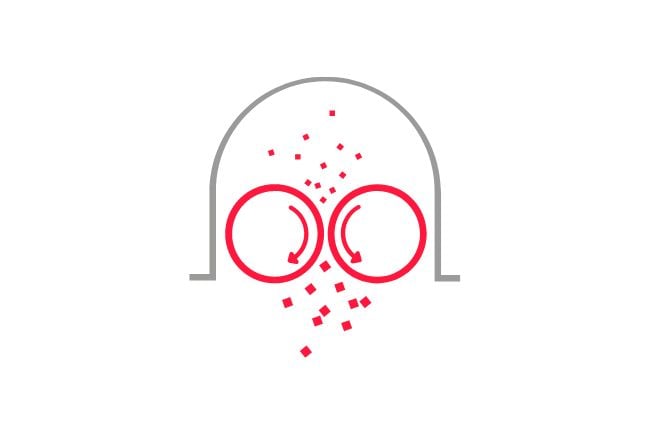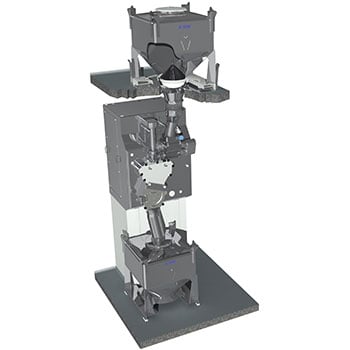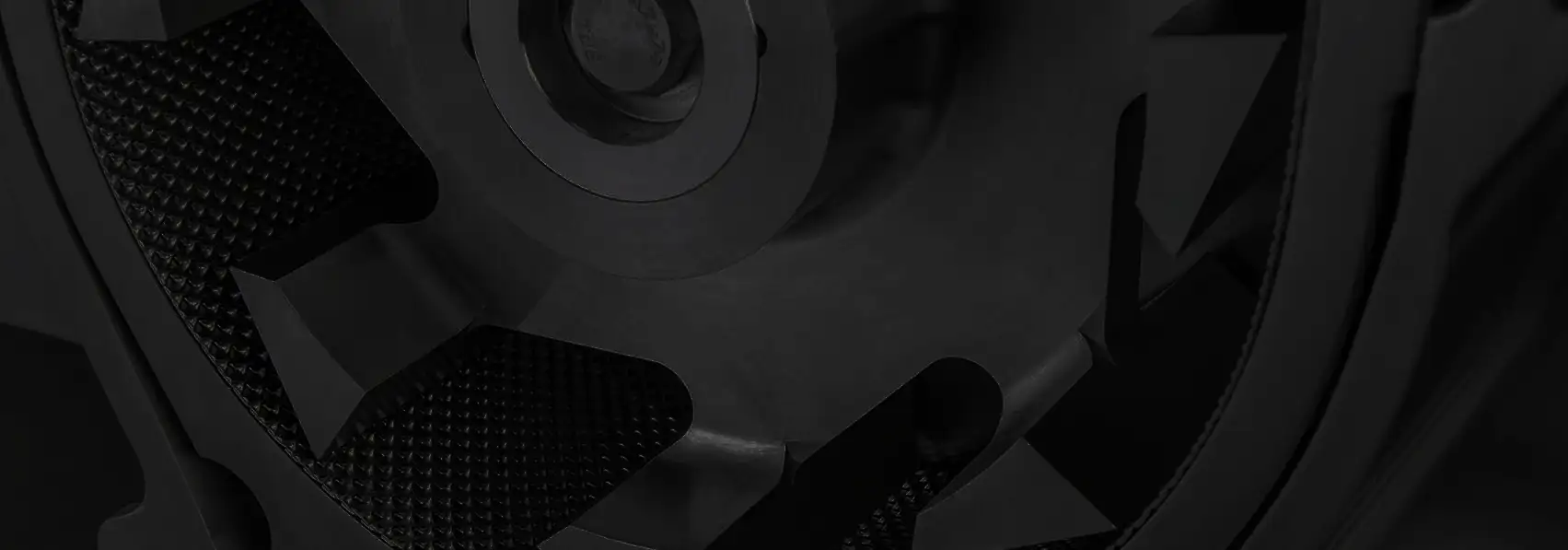Many pharmaceutical Dry Granulation projects require a very high level of containment which is beyond the limits of the standard equipment design. The responsibility for specifying the containment levels lies with the end-user, who will decide based on their risk analysis and exposure limits of the product.
Users will opt to create an additional, secondary containment structure around the processing equipment - this takes the form of an isolator. It should be noted that our processing equipment is inherently well contained, so the auxiliary containment measures being discussed here are only required for the most demanding of applications.
With high potency compounds, secondary containment may be required for feeding and discharging the product as well as for cleaning and maintenance.
What are the options for enhanced containment when milling and granulating?
Over the years, The Fitzpatrick Company has been involved with the design and operation of a wide variety of styles of containment suites, which have been integrated with our milling and roller compactor processing equipment. In this article we are taking a look at the pros and cons of two of the most commonly used styles of powder containment isolator:
Rigid Isolators
Where a solid isolator, typically constructed from stainless steel and glass, is built around and is permanently attached to, the primary processing equipment in a fixed configuration. Access is typically via Rapid Transfer Port (RTP) and Split Butterfly Valves (SBV).
Flexible isolators
Here polymers and plastics are used to construct the containment isolator walls. Access is achieved via high containment, zipped transfer ports, or continuous liner systems. These isolators aren’t typically integrated into the processing equipment, which means the isolator can be removed or reconfigured as required.
The containment isolator can completely surround the entire piece of equipment or encase only the processing components. Deciding which to use should consider the level of contamination that is likely to affect the difficult to clean power system section and the method of venting motor heat.
The isolator can be an integral part of the operation, feeding, discharge, and maintenance of the unit operation. In general, the processor is operated using a combination of the remote interface, access ports, and in situ glove ports.
What are the differences between the containment options?
The table below summarizes some of the main differences between the two types of isolators – it is important to consider these differences when making the selection for your specific application:
| RIGID ISOLATORS | FLEXIBLE ISOLATORS | |
|---|---|---|
| Containment Effectiveness | High | High |
| Initial Cost | High | Low |
| Lead Time | Months | Approx. half the time of an equivalent rigid system |
| Ongoing Cost | Cleaning & typical preventative maintenance | Costly consumables, removal & reinstallation, containment validation |
| Cleaning Validation | Cleaning, swabbing & validation of process equipment & isolator | Cleaning, swabbing & validation of process equipment only. Disposal of isolator. |
| Flexibility | Inflexible | Highly flexible |
| Intermittent Deployment | No | Yes |
| Negative Pressure | Not limited in practice |
-30 Pa typical +60 Pa aseptic |
| Chemical Compatibility | High | Limited solvent resistance |
Containment effectiveness
Both types of isolator can achieve OEB5 containment. However, the effectiveness of the containment method is, in part, reliant upon the competency of the operators. At OEB5 levels, both types require an above standard level of care and operator competency. As rigid isolators are fixed in position, there is generally less operator interaction required to assemble the isolator.
The preferred approach for rigid wall and flexible isolator design is to keep the power system and sensitive control operator interfaces outside the isolator using fittings and/or adhesive tape. This strategy ensures a minimum volume of the contaminated isolator that needs to be cleaned, with simple protocols prior to containment being broken between batches.
The level of risk should be considered when selecting the design of containment isolator. For example, with a high-risk application, the rigid isolator will monitor the vacuum level inside the isolator and increase the vacuum flow to maintain a suitable velocity across the inlets, which is maintained even if a glove is accidently pulled off. For lower risk, infrequently used applications, the flexibility to reconfigure the isolator may be more important as the deciding factor.
The manner of material handling should also be considered in the selection of the containment isolator. If larger product batches are required, feeding from a liner or IBC, then a split butterfly valve (SBV) may be required for continuous flow. If an SBV or multiple ports are required, then these are more easily integrated into and used with rigid isolators.
If smaller batches are required with more frequent product changeovers, then bag-in/bag-out is simpler and would work with either rigid or flexible isolators.
Initial & Ongoing Costs
Rigid systems tend to require a significantly higher initial investment cost as their construction utilizes more expensive materials and often requires customized manufacturing to connect to specific process equipment.
In terms of lifetime costs, the flexible isolators have higher ongoing consumables costs. A replacement flexible wall isolator is more expensive than the cost of cleaning, swabbing and re-certification of a rigid wall isolator.
Buyers should calculate the long-term investment costs, comparing initial investment and batch-to-batch turnaround expenses including cleaning, validation, replacement costs and operator time.
The application requirement may also be evaluated as it pertains to the cost of containment. For example, if most products in the company portfolio do not require a containment isolator, then the flexible isolator may be easier and less costly to install, as it will only be deployed as and when necessary for that specific product batch. When other products that don’t need high containment are being made, the flexible isolator can be removed making the equipment easier to use.
Lead Times for Containment Systems
The lead time for a rigid containment system tends to be significantly longer than that of the flexible isolator. This is because rigid isolators are custom-designed to fit the processing equipment and application, connecting to a specific piece of equipment rather than simply surrounding/attaching to it. Even though they may well be manufactured from stock materials, with the addition of some standardized components, the designing and made-to-order nature will lengthen the delivery time which can run into several months.
Flexible isolators can also have an application-specific design. But because this isolator merely surrounds the equipment it is easy to modify readily available, standard components to fit the need. When glove positions need to be repositioned, due to changes in operation or based upon operating experience, gloves can quickly be relocated at a low cost the next time the curtain wall is replaced.
Lead times should also be taken into consideration for spares, replacement parts, and replacement isolators. Flexible isolator systems are quickly replaced with a new clean isolator by retaining the isolator’s frame and supporting equipment and switching out the wall materials. The contaminated, used materials are compressed, bagged and properly disposed of.
Rigid isolators do not wear out and their performance does not degrade over time, assuming proper care and maintenance. Where economically viable, users should consider having critical spares on hand.
Maintenance & Batch-to-Batch Turnover
Maintenance on rigid isolators, for the most part, involves cleaning between batches and ensuring static and mobile seals are intact. Tight tolerances on rigid isolator RTPs (Rapid Transfer Ports), must be carefully maintained. Rigid isolators are designed with static, re-usable components that are cleaned and validated between batches. Cleaning, swab testing, drying and validation take time and money. These commitments related to rigid isolators should be compared to the cost of disposal of the components on a flexible system.
Flexible isolators rely on single-use components, particularly for product contact parts. If the flexible isolator includes a pressurization system, then the whole unit may be collapsed under negative pressure without breaking the seal. It is very convenient to simply remove and discard contaminated parts of the isolator, but these parts and their disposal will incur costs and their environmental impact should be taken into account.
Equipment downtime for cleaning and cleaning validation must be considered.
Flexibility & Intermittent Deployment
If an isolator is designed for a single unit operation for its entire lifetime and is planned to be used on a daily basis for essentially the same operation, then flexibility is not an important consideration. A purpose-built, customized system is not a limitation and therefore a rigid isolator would function well in this instance.
If, on the other hand, the processing equipment might be deployed for different, less potent, applications or the process might change or evolve over time, then the flexible containment systems have the advantage of being reconfigured with relative ease and speed. They can also take advantage of advancements in technology and design improvements without requiring significant design changes as would be required with a fixed installation.
Negative Pressure
In some applications, a low-pressure vacuum may be applied within the isolator to ensure the inward flow of air towards the processor i.e. away from the operator and the operator’s environment. The stiff shell of a rigid isolator system works well if negative pressure is to be applied to the process. Flexible isolators have a framework support to minimize walls curving inward during operation.
Chemical Compatibility
Rigid isolators are typically constructed from inert materials such as glass and stainless steel, that are FDA compliant, for cleaning with a variety of liquids. Chemical compatibility is typically not a concern. With rigid isolators, the higher level of solvent compatibility helps with future-proofing the isolator. If the nature of the solvents potentially required in the future is not known at the time of specification, then the rigid wall systems have a better chance of future compatibility.
Flexible isolators, on the other hand, are made from polymers, so the material of construction should be considered when specifying cleaning agents and must be compatible with the material being processed.
With Fitzpatrick roller compaction equipment, the majority of the materials of construction are stainless steel and glass, with a limited array of polymers, so a rigid isolator is less likely to introduce additional Materials of Construction (MOC) to be accommodated.
Temperature Compatibility
High temperature is typically not an issue with rigid systems. But flexible isolators may be more affected by the temperature if high-temperature operations are planned.
With both rigid and flexible systems, provision to exhaust or cool the environment may be needed if the process requires it. Heat generation is generally limited with Fitzpatrick equipment but may be a serious consideration with other models or processes such as spray dryers.
In Summary
Containment Isolators (rigid or flexible) are just a couple of the available containment solutions. There are many factors influencing the choice of isolation technology, ranging from the potency of the product, to the frequency of operations, quantity and method of material handling.
At The Fitzpatrick Company, we have worked with all types of containment isolators and can help you make the right decision for your application. Over many years and a corresponding number of projects, Fitzpatrick have developed inherent options that work to maximize the safety of the operation. We have experience developing systems in collaboration with specialist containment manufacturers for highly contained pharmaceutical systems.
We recommend a discussion with the equipment manufacturers and isolation technology providers working in partnership to deliver the best, safest and most cost-effective solution for your process.
If you would like to talk to one of our technical experts, then please do get in touch.



